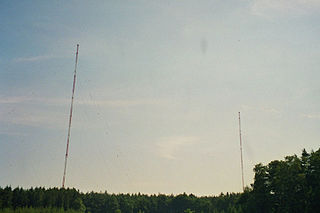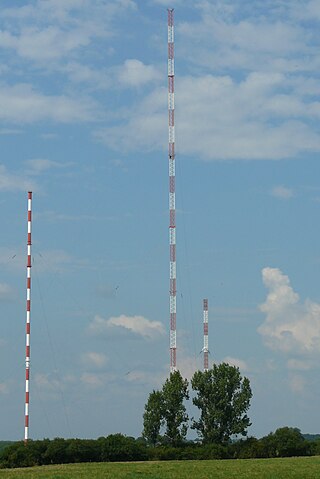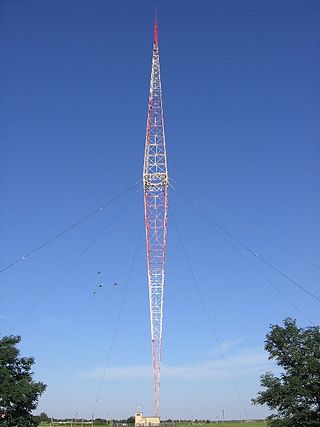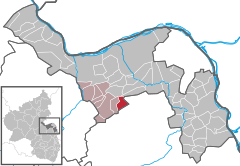
Medium wave (MW) is the part of the medium frequency (MF) radio band used mainly for AM radio broadcasting. The spectrum provides about 120 channels with more limited sound quality than FM stations on the FM broadcast band. During the daytime, reception is usually limited to more local stations, though this is dependent on the signal conditions and quality of radio receiver used. Improved signal propagation at night allows the reception of much longer distance signals. This can cause increased interference because on most channels multiple transmitters operate simultaneously worldwide. In addition, amplitude modulation (AM) is often more prone to interference by various electronic devices, especially power supplies and computers. Strong transmitters cover larger areas than on the FM broadcast band but require more energy and longer antennas. Digital modes are possible but have not reached momentum yet.
Low frequency (LF) is the ITU designation for radio frequencies (RF) in the range of 30–300 kHz. Since its wavelengths range from 10–1 km, respectively, it is also known as the kilometre band or kilometre wave.

Sender Zehlendorf or Zehlendorf (radio) transmission facility was a radio transmission facility which was in service since 1936, when a short wave transmitter was built on the occasion of the Berlin 1936 Summer Olympics in Zehlendorf as part of the establishment of permanent radio services. This Zehlendorf site, which until the end of World War II was referred to as the Rehmate Radio Transmission Centre, had 26 different antennas at the time.

The Sender Donebach was a 500-kilowatt long wave radio transmitter operating on 153 kHz and transmitting the program of German public broadcaster Deutschlandfunk. The facility, which was the property of Media Broadcast, was built between 1965 and 1967 on a former airfield, and entered service on March 10, 1967.

The Allouis longwave transmitter has been France's central longwave broadcast transmitter since 1939. It is located near the village of Allouis.

The Roumoules transmitter is the main broadcasting facility for longwave and mediumwave broadcasting of Radio Monte Carlo near Roumoules, France and is owned by Monaco Media Diffusion. The 1000 and 2000kW transmitters installed are among the most powerful in the world and can be received well at nighttime throughout Europe.

The Mühlacker Broadcasting Transmission Facility is a radio transmission facility near Mühlacker, Germany, first put into service on November 21, 1930. It uses two guyed steel tube masts as aerials and one guyed steel framework mast, which are insulated against ground. It has two transmission aerials for shortwave and one free standing steel framework tower for directional radio services. The shortwave transmitter was shut off on October 19, 2004. The medium wave transmitter was switched off in January 2012.

The Langenberg transmission tower is a broadcasting station for ananlog FM Radio and Digital-TV signals. It is located in Langenberg, Velbert, Germany and owned and operated by Westdeutscher Rundfunk, WDR.

The Transmitter Ismaning was a large radio transmitting station near Ismaning, Bavaria, Germany. It was inaugurated in 1932. From 1932 to 1934 this transmitter used a T-antenna as transmitting antenna, which was spun between two 115-metre-high free-standing wooden lattice towers, which were 240 metres apart. As this antenna had an unfavourable vertical radiation pattern, which produced much skywave resulting in a too small fading-free reception area at night, in 1934 a new antenna was installed. Therefore, one of the towers was dismantled and rebuilt on a 39-metre-high (128 ft) wooden lattice base. While this work took place, an L-Antenna was used, which was spun between the other tower and a small auxiliary wooden tower. It became defunct in 1977 and was destroyed in 1983.

The Wachenbrunn transmitter was a large broadcasting facility for medium wave in Wachenbrunn near Themar, Thuringia, Germany, established in the 1950s. Until 1993 the main transmitter of this facility, the medium wave transmitter for 882 kHz was run with 250 kilowatts. In that year the transmission power of this transmitter, which was formerly used for transmitting the "Voice of DDR" and since the beginning of the 1990s for "MDR info" was reduced to 20 kilowatts.

The Rheinsender is transmitting site of German Südwestrundfunk for FM-Radio. It is located near Wolfsheim, southwest of Mainz.

The Cremlingen transmitter is a large mediumwave transmission facility established in 1962 for transmitting the programme of Deutschlandfunk on 756 kHz near Cremlingen-Abbenrode. It was also known as Sender Braunschweig or Sender Königslutter.

The Heusweiler transmitter was a facility for medium wave broadcasting north of Heusweiler, Germany. It originally went into service on 23 December 1935. On 19 June 1946 transmitter Heusweiler went in service again.

The Lakihegy Tower is a 314-metre-high (1,031 ft) radio mast at Szigetszentmiklós-Lakihegy in Hungary. The Blaw-Knox type tower was built in 1933 and was one of Europe's tallest structures at the time of construction. It was designed to provide broadcast coverage for Hungary with a 120 kW transmitter. It was built for the purpose of transmitting the radio station "Budapest I.", which it served until 1977.
The mediumwave transmitter Flevoland was a broadcasting facility for medium wave near Zeewolde in the province of Flevoland, Netherlands, situated at 5°25′ E and 52°23′ N. It has been used for broadcasting on 747 kHz and 1008 kHz with a nominal power of 400 kilowatts. As aerial two guyed steel framework masts with a height of 195 metres are used, which form an anti-fading aerial. These masts are grounded and carry a cage aerial, which is upperward the separation insulator, separating the masts in a height of 95 metres in two parts, connected toward the mast construction. The radiation diagram is directional, with a maximum gain of 4 dB in South-Eastern direction, to compensate for the variation in electrical admittance of terrain in the Netherlands.
A broadcast transmitter is an electronic device which radiates radio waves modulated with information content intended to be received by the general public. Examples are a radio broadcasting transmitter which transmits audio (sound) to broadcast radio receivers (radios) owned by the public, or a television transmitter, which transmits moving images (video) to television receivers (televisions). The term often includes the antenna which radiates the radio waves, and the building and facilities associated with the transmitter. A broadcasting station consists of a broadcast transmitter along with the production studio which originates the broadcasts. Broadcast transmitters must be licensed by governments, and are restricted to specific frequencies and power levels. Each transmitter is assigned a unique identifier consisting of a string of letters and numbers called a callsign, which must be used in all broadcasts.
The Domžale radio transmitter is a facility for medium wave broadcasting in Domžale, in Slovenia. The transmitter is fully transistorized. It could be received easily at a medium wave frequency of 918 kHz across the whole of Europe at night-time. It was the strongest radio transmitter of the Republic of Slovenia, broadcasting the first national radio channel.
Goliath transmitter was a very low frequency (VLF) transmitter for communicating with submarines, built by Nazi Germany's Kriegsmarine navy near Kalbe an der Milde in Saxony-Anhalt, Germany, which was in service from 1943 to 1945. It was capable of transmission power of between 100 and 1000 kW and was the most powerful transmitter of its time.

The Wiederau transmitter is the oldest broadcasting facility in Saxony. It is located near Wiederau, a village which is part of the municipality of Pegau, and is used for medium-wave, FM and Television broadcasting.

The Tower of Power is a 777 ft (236.8 m), 120,000 watt TPO mast owned by the GMA Network located in Tandang Sora, Barangay Culiat, Quezon City. It serves as a transmitter facility for GMA's flagship stations, including DZBB-TV 7, GTV's DWDB-TV 27, and Barangay FM's DWLS 97.1 MHz.



















